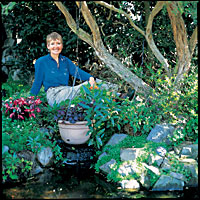From Empty Lawn to Tropical Oasis
Is it possible to grow a lush garden filled with exotic vegetables, fruits, and flowers in a climate that gets only 11 inches of rainfall a year and often has watering restrictions? Just ask Shelley Grossman in Carlsbad, California. Not only has she turned her half-acre lot into a tropical paradise, she's created a model lifestyle in green-waste reduction and water recycling. "Saving water is the right thing to do," she says. "Locally, nationally, and globally we're facing water shortages. I'm trying to live as I preach about the need for water conservation," says Shelley.
 Water-Wise Gardener Shelly Grossman is Runner Up in the "My Garden Story" contest.
Water-Wise Gardener Shelly Grossman is Runner Up in the "My Garden Story" contest.Green Beginnings
Growing up in Southern California, Shelley can't remember a time when she didn't garden. "Even in college I had a huge garden and gave tons of food away," she says. When she moved 15 years ago to her present home in Carlsbad, tucked north of San Diego along the coast, she knew the yard needed work. "The house had been built in an old avocado orchard. Other than a few old fruit trees, the yard was mostly lawn," she says. The previous owner had 12 trash cans that he used to haul grass clippings and shrub trimming to the dump. "I thought there had to be a better way."
Yard Makeover
For Shelley, there was a better way. Her first step was to bid farewell to the gardener who had been tending the property, and take on the role herself. She covered the lawn in grass clippings, newspaper, mulch, and black plastic, and within 3 weeks the lawn was no more. Using compost bins from Gardener's Supply, she started making compost from all the green waste she could find in her own yard and as much as she could get from her neighbors. She built a meandering stone wall, planted foundation shrubs of bougainvillea, privet, melaluka trees, and cape jasmine, and started designing a diverse landscape that would eventually become a certified wildlife habitat.
Today Shelley's yard features flowers such as bottlebrush, freesia, and honeysuckle, a mini-orchard filled with apples, oranges, apricots, pears, and plums, herbs such as chives, rosemary, and lavender, a pond, and raised vegetable beds where she grows tomatoes and other vegetables year round. She uses gray water to water her ornamental plants, and collects rain water to water the edible plants, fill her swimming pool, and even wash dishes. "There's little water wasted in our home," she says.
Vermicompost Queen
How does Shelley maintain such a large and abundant garden? Her secret is compost and earthworms. "When I first started composting I would notice lots of worms in the bins," she says. "One day a friend introduced me to the idea of vermicomposting (composting with earthworms), and I've been hooked ever since." Shelley has 68 worm bins in her backyard in a north facing area behind the garage where she produces worm casings and worms for use in her own garden and for sale. But her real mission is education. She has published a book and video on composting with worms, written articles in national publications such as Biocycle Magazine, and taught groups such as Master Composters and Master Gardeners about using worm bins. She has worked in schools using worms to teach students about waste reduction. "I love teaching and spreading the word about how worms can turn organic waste into such a beautiful soil amendment," she says.
Shelley has won awards for her teaching work in area schools and has helped create the state's first zero waste facility at one private school.
Wiggly Future
Shelley is far from finished with her green revolution. She would love to install a composting toilet in her home, but her husband isn't quite ready for that yet. In her consulting business, she's looking to spread the word about vermicomposting around the world. "Countries in Asia and Europe are much more open to the benefits of worms than we are here," she says. "I think this technology can help many countries grow more of their own food."
Print this Article:
Get the Dirt
Stay up to date on new articles and advice. Please fill out the information below.
